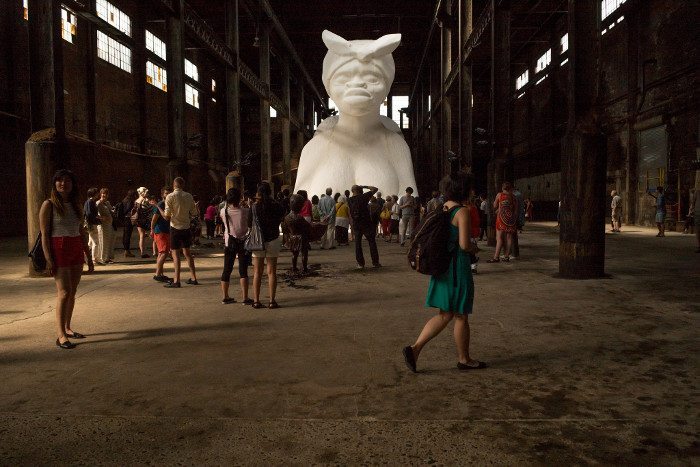What Kara Walker’s ‘Sugar Baby’ Showed Us
The controversial photos that some visitors took at the exhibit are not only troublesome because they disrespect the art, but because the mocking and dehumanization of the Black female body has a long history in our society.

This piece is published in collaboration with Echoing Ida, a Forward Together project.
Kara Walker’s latest art installation A Subtlety, or the Marvelous Sugar Baby, which was on display at the Domino Sugar Factory in Brooklyn from May 10 until July 6, has been the topic of discussion for many people since it opened.
Like most of her art installations, A Subtlety had strong political, historical, and racial themes. Walker says she created the art installation as homage to the unpaid and overworked women who refine sugar from sugar cane to the sugar many of us consume everyday.
Among the sculptures on display, Walker created a “mammy sphinx” composed of 30 tons or so of sugar. The massive sculpture was completely naked except for the typical headscarf worn by many Southern Black women—today and years ago.
Some spectators of the installation have been criticized for taking sexually suggestive photos with the body parts of the exposed sugar sphinx. The backlash from people who felt these photos were insensitive was swift and prompted questions about the ways in which Black art is valued, and how public displays of resistance can help improve how Black art is treated and viewed by spectators.
While some people regard the photos as a “joke,” critics saw the photos as a continuation of the pain Black women have lived with and continue to live with, from the forced sterilization of many Black women and women of color in the past and today, and Black women and women of color having birth control tested on them.
The controversial photos taken at the exhibit are not only troublesome because they disrespect the art, but because the mocking and dehumanization of the Black female body has a long history in our society.
After seeing the photos, I wanted to know how spectators could in good conscious photograph in sexually suggestive ways an installation that eerily replicated a position of one of Dr. J. Marion Sims’ enslaved Black female victims; this photo is one of the few available that presents as human mostly nameless and devalued Black women whose bodies were used to build the modern field of women’s reproductive health.
Sims is regarded as the founder of gynecology. In a period of four years, he performed invasive vaginal surgery on approximately 14 enslaved Black women, whom he rented or purchased for this very reason. Despite the invasiveness of the surgeries and how often they occurred, Sims did not provide anesthesia to any of the women. By his personal account, he performed 30 surgeries on just one of his victims. Only three of the women’s names were documented, and to this day many of them remain nameless. Barely known for their forced contributions to science and medicine, they are one of the true reasons the field of gynecology exists as it does today.
The sugar sphinx was a prodigious representation of the many Black women who worked under deadly and forced labor conditions all while remaining nameless and barely known.
And so I ask: How could those spectators visit an exhibit and pose in a sexually suggestive manner with artwork paying homage to women who are exploited and often working in the shadows of society and show little regard for the artwork and the other women in the room, especially the Black women, some of whom were moved to tears because of the emotional impact the installation had on them?
Empires, fields of medicine, countries, and entire societies have been and continue to be built at the expenses of forced labor of Black women. However, they garner little to no respect. Instead, even in death, they continue to be exploited, while those who exploit them continue to be regarded as heroes, like in the case of Dr. Sims, who has a statue memorializing his “achievements” in medicine in Central Park. The spectators who chose to enter one of the very few spaces dedicated to paying respect to the long history of pain, suffering, death, and exploitation of the Black female body all for a “silly photo” are replicating and continuing the same lack of respect and or indifference the city of New York has displayed when asked to remove Sims’ controversial statue.
The Sugar Baby’s marvelous and imposing stature, headscarf, nakedness, and balled up fist embodied a proud Black woman. A woman who, despite the forced labor conditions she worked under, the unpaid labor she put out, and the complete exposure of her body, still held her head high and invoked the pride of the Great Sphinx of Giza.
Sugar Baby was the complete foil to the statue of Dr. Sims.
While the Sugar Baby and her proud stance will be taken apart and hauled off to recycling plants, granules of her may linger behind and drift into the East River or be mixed in with the materials that will be used to construct new luxury condos in the very spot that housed her, following the imminent destruction of the Domino Sugar Factory.
But for many, she will remain in our memories as the Sugar Baby who showed us—Black women—to remember that we are powerful, deserve to take up space, and are capable of inspiring other women to feel these things too. These fleeting spaces of Black female empowerment through temporary art installations are one of the few opportunities us Black women get; the least spectators can do is educate themselves and comport themselves in the same way they would when viewing the Mona Lisa.
